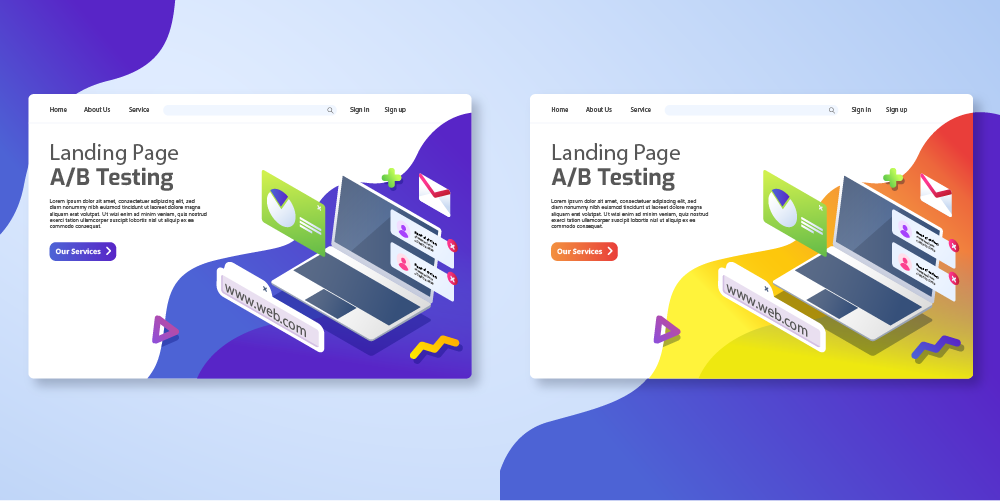No digital marketer is Mr Omniscient and no digital content is Mr Right. As it is impossible to get into users’ heads and see what we publish with their eyes, we cannot be sure which version of a website, ad, or landing page will perform best. Our decisions can be improved as we gain experience, but it will probably be nowhere close to an effective solution based on data. Since every person seeing an ad or visiting a website creates possibilities for a company to either get a new customer or create additional interest in an existing one, it is worth improving on these decisions.
What is the data-driven solution that we praise above? It is A/B Testing (sometimes referred to as split testing) defined as showing 2 variants of the same piece of content to different segments of audience at the same time. It allows marketers to find out what is working and what is not – or which version performs significantly better so as to be chosen over the other one.

What is A/B Testing?
In order to understand the idea of A/B Testing, let’s start from the beginning. Why do marketers create content on websites, landing pages, social media platforms, blogs or in the form of paid ads? They aim to increase traffic and desirably convert visitors into customers, leading them down the conversion funnel. A/B Testing is a way to optimize this funnel by means of analyzing what drives more conversions and deciding on a more effective solution. Overall, the process of optimizing conversion rate is called CRO (Conversion Rate Optimization). As there are many common issues which can negatively influence conversion such as user pain points, it is worth testing to make sure that none of such problems is left unsolved. A/B Testing can bring such improvements as the aforementioned higher conversion, but also increased website traffic, lower shopping cart abandonment or decreased bounce rate.
The benefits of A/B Testing
A/B Testing allows marketers to avoid big redesign decisions, making it possible to apply only small changes to observe user behavior and draw conclusions. Minimized modifications are likely to bring significant results which means that high gains can be achieved with relatively low cost. The process of A/B Testing is fully data-driven and measurable which makes it easier to formulate marketing strategies with no blind guessing and being biased by personal preferences. Moreover, it lets marketers check on numerous elements and types of content which means that this technique really is multi-functional and reduces various risks – from ad efficiency to the final conversion rate.

What can be tested?
Deciding on what to test is a challenge on its own. Let’s say your landing page is not converting as you wish – but how can you know what should be changed? The possibilities are numerous. Headlines are crucial as they are the first thing that most of the users look at – are they compelling enough? What about the colors and fonts? The body is the message you send to your potential customers. It is worth analyzing if the copy is clear enough and whether the language used is aligned with your goals. Wording should be consistent with the brand image across channels and appropriate for a given audience. Users might bounce out fast if the navigation is unclear and creates confusion, or if they do not find our CTA convincing enough to click. Finally, many landing pages include forms. Marketers need to balance the amount of quality information they can collect with minimizing friction for modern users who do not want to spend too much time filling in the information.
However, landing pages are not the only A/B Testable content. What comes before them in the marketing funnel are ads that users are exposed to while searching through the web. Too a low conversion rate does not necessarily mean that there is a problem with your landing page. On the contrary, it may be just fine, but the issue might lay in the ads which is the entrance to your landing page. For example, if the visuals or messaging are inconsistent with the actual offering presented on the website, users will bounce out, feeling that they were searching for significantly different content. We wrote more about it in our previous article discussing the issue of promises that brands make in ads and are expected to keep further in the user experience journey.
Plan, plan, plan… and execute
A/B Testing needs to be planned well in order to bring meaningful results. Let’s go through the process to let you understand each step along the way. First things first, conduct proper research on how the content is currently performing and understand what the goals that you want to achieve with the help of this particular content – be it a website, landing page, or an ad. You can use tools such as Google Analytics, heatmaps or session recording. Think about what might be bad or good about your strategy – through the eyes of a user. Secondly, identify one variable to test, create hypotheses based on the collected data and how that should be formulated. Next, sample groups should be defined – keeping in mind that they should be picked randomly and be of similar size. You also need to determine how significant the result needs to be for the A/B Test to be regarded as successful. When all these steps are completed, you can start testing with an A/B Testing tool of your choice.
What do I do next?
Conducting the test is just part of the process. It is crucial to properly understand the winner – and the reasons behind a certain result. Identifying these reasons allows marketers to learn from their experiments and use this knowledge in future strategy formulation. The winning variation is then utilized, and the team can move on to conducting the next A/B Test – and plan the following ones. It is important that A/B Testing becomes a good habit in the marketing department – not a one-time event.

Conclusion
A/B Testing really is a powerful technique that lets brands to achieve better results online, engaging more users and acquiring new customers more effectively. Provided they do not test too many elements together and get biased by marketers’ own opinions or other factors, A/B Test results are a valuable insight into what can be improved in the messaging that a company sends to its online audience. “Never stop testing. And your advertising will never stop improving” said David Ogilvy and he just could not be more right here.